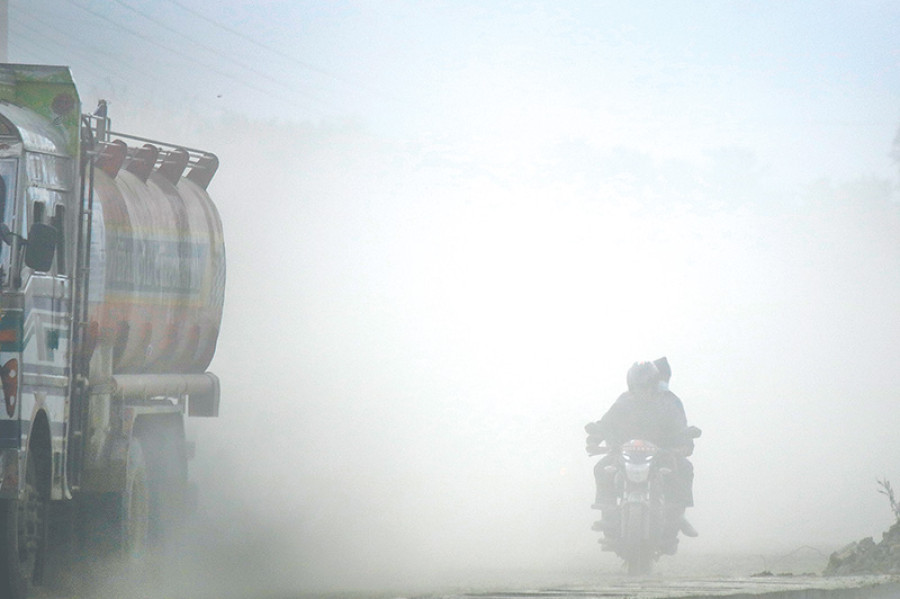Money
It’s in the air
In January, Nepal was ranked at the bottom on a list of 180 countries surveyed for their air quality.
Chandan Kumar Mandal
In January, Nepal was ranked at the bottom on a list of 180 countries surveyed for their air quality. The global Environmental Performance Index (EPI), an annual report by Yale University and Columbia University in collaboration with the World Economic Forum, highlighted air pollution as a leading threat to public health and thus measured household solid fuels, exposure to Particulate Matter (PM) 2.5 and the level of PM2.5 in the air. With a score of 3.94 and a rank of 180, Nepal’s air quality was worse than any other country in the region, behind even China (177th), India (178th) and Bangladesh (179th).
This low ranking was not unexpected but few had thought that Nepal’s air quality would be the poorest in the world. Every year, especially during the winter, the country’s major cities choke on dust, smog and other pollutants. The Air Quality Index (AQI), which calculates pollutants in the air, has reached record highs in recent years, vaulting over the levels prescribed by the World Health Organisation (WHO).
Vehicle exhaust, along with smoke from brick kilns and dust from construction, is often held to be the chief source of this pollution. The transport sector contributes over 30 percent of total suspended particles (TSP), or 20,072 tons, into the air, according to the 2017 Air Quality Management Action Plan for Kathmandu Valley. The transport sector further contributes 30 percent of PM10, second only to the construction sector, which emits 53 percent of the total PM10.
With the number of motorised transport increasing in the Valley, environmentalists, public health experts, policymakers and the public continue to debate measures to fight air pollution, which is only likely to increase in the coming days. As an alternative, environmentalists have long been advocating for the promotion of electric vehicles (EV) as a replacement for vehicles that run on petroleum.
“In the long run, we need to promote and ultimately opt for electric vehicles if we want to improve our air quality,” says Rajan Thapa, coordinator of Clean Air Network Nepal.

Last year, in September, the then Health Minister Gagan Thapa tabled a proposal in Parliament, which aimed to contribute to the growth of electric vehicles in the country by banning sale and distribution of all fossil fuel-run vehicles in the Kathmandu Valley by 2027 and across the nation by 2031. Besides, the government has also come up with an ambitious Environment-friendly Vehicle and Transport Policy (2014) which aims to cut emissions from the transport sector and increase the share of EVs to up to 20 percent by 2020. A daunting and unlikely goal for the next two years.
Improving air quality through the adoption of EVs looks like a distant dream. Therefore, the government needs to turn to other options, like a mass transport system, says Thapa. “Even when we are encouraging the public to take up electric vehicles, we are concentrating on electric cars, adding to the congestion of our streets,” he says.
Improving the public transport network is often prescribed as one of the most significant measures to reducing vehicle exhaust. A reliable public transport system will cut down on the use of private vehicles, ultimately cutting down on vehicle emissions, according to experts. Thapa suggests that sections of Kathmandu roads, like the Ring Road, should incorporate Bus Rapid transit (BRT), a system where buses have their own dedicated lanes, making them faster than other means of transport. BRT has been implemented in cities across the world to provide fast, comfortable and cost-effective services in metros like the Kathmandu Valley.
Mass public transport and electric vehicles are a long time coming. In order to deal with the pollution now, the government, on March 15, had imposed a ban on that vehicles more than 20 years old from plying the country’s roads. The timely maintenance of vehicles greatly determines the kind and amount of exhaust that they let out, says transportation and traffic engineer Ashish Gajurel.
“Servicing of vehicles has to be conducted on a regular basis. Old vehicles tend to emit more pollutants, but if these vehicles are serviced regularly, even their emissions will be lower,” suggests Gajurel. The import and use of quality fuel for vehicles are also equally important in controlling emissions and reducing air pollution, he adds.
The government awards green stickers to vehicles that have permissible emission levels for all five metropolises in the country—Biratnagar, Birgunj, Bharatpur, Pokhara and Kathmandu. However, simple observation would show vehicles flaunting their green stickers while visibly emitting noxious levels of pollutants. Random tests for vehicular emissions, jointly conducted by the Department of Environment (DoE), the Metropolitan Traffic Police Division (MTPD) and the Department of Transport Management (DoTM) between November 2017 and July 2018, found that 635 vehicles out of a total 1,374, were emitting smoke and other particles higher than government standards.
The DoTM has now installed 40 sets of equipment to test emissions at its offices, including all 14 erstwhile zonal offices, Thulo Bharyang and Sallaghari in Kathmandu Valley, Bharatpur, Dadeldhura, and Biratnagar. Vehicle Emission Tests (VET) are mandatory in all major cities.
“Vehicles emitting black smoke but holding green stickers should be penalised and their stickers replaced with red ones,” says Thapa. He believes that strict implementation of the green sticker provision, the promotion of efficient vehicles, reducing dependency on fossil fuels, and introducing mechanisms to check the quality of fuel can help cut vehicular emission drastically.




 18.12°C Kathmandu
18.12°C Kathmandu













%20(1).jpg&w=300&height=200)
